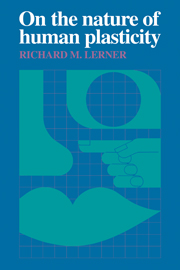Book contents
- Frontmatter
- Contents
- Foreword by Paul Baltes
- Preface
- 1 Perspectives on plasticity
- 2 The life-span view of human development: philosophical, historical, and substantive bases
- 3 Gene marking, recombinant DNA technology, and gene transfer: toward true gene therapy
- 4 Neuroanatomical bases of human plasticity
- 5 Human neurochemistry and the role of neurotransmitters
- 6 Evolutionary biology and hominid evolution
- 7 Comparative-developmental psychological bases of plasticity
- 8 Individual and group interdependencies
- 9 Toward future multidisciplinary efforts
- 10 Conclusions: On the limits of plasticity and the plasticity of limits
- References
- Author index
- Subject index
Foreword by Paul Baltes
Published online by Cambridge University Press: 22 March 2010
- Frontmatter
- Contents
- Foreword by Paul Baltes
- Preface
- 1 Perspectives on plasticity
- 2 The life-span view of human development: philosophical, historical, and substantive bases
- 3 Gene marking, recombinant DNA technology, and gene transfer: toward true gene therapy
- 4 Neuroanatomical bases of human plasticity
- 5 Human neurochemistry and the role of neurotransmitters
- 6 Evolutionary biology and hominid evolution
- 7 Comparative-developmental psychological bases of plasticity
- 8 Individual and group interdependencies
- 9 Toward future multidisciplinary efforts
- 10 Conclusions: On the limits of plasticity and the plasticity of limits
- References
- Author index
- Subject index
Summary
Plasticity is a concept whose significance in developmental scholarship waxes and wanes, as the past decades of this century bear witness. For example, the term was a major entry in the 1902 edition of J. M. Baldwin and E. P. Poulton's Dictionary of Philosophy and Psychology. It was defined as “that property of living substance or of an organism whereby it alters its form under changed conditions of life” (Vol. 2, p. 302). At that time and under the recent influence of Darwinian thought, the discussion of plasticity focused on its origins and role in evolution. In the thirties and forties, plasticity (or modifiability) was again a center of attention. There was Lashley's conception of brain plasticity as well as the early-childhood studies of the detrimental impact of environmental deprivation and, correspondingly, the possible benefits of compensatory programs.
The 1970s and 1980s have seen renewed interest in the notion of plasticity. Research, rather than being restricted to childhood, is now being done, for example, in psychological gerontology, where it has been found that aging is not a fixed general process of decline, but rather that the older organism retains considerable potential for variability and plasticity. Similarly, in continuation of Lashley's earlier ideas, groundbreaking work is now being done in developmental psychobiology (e.g., Gollin, 1981) that underscores the need to study and articulate models that explicitly focus on variations in development.
- Type
- Chapter
- Information
- On the Nature of Human Plasticity , pp. ix - xPublisher: Cambridge University PressPrint publication year: 1984



